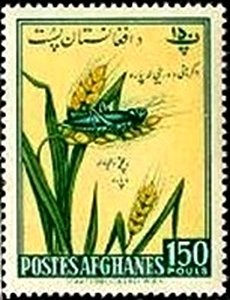Stamp: Grain, Grasshopper (Orthoptera) (Afghanistan 1961)
Grain, Grasshopper (Orthoptera) (Afghanistan 1961)
21 March (Afghanistan ) within release Agriculture Day goes into circulation Stamp Grain, Grasshopper (Orthoptera) face value 150 Afghan pul
| Stamp Grain, Grasshopper (Orthoptera) in catalogues | |
|---|---|
| Michel: | Mi:AF 528 |
| Stamp Number: | Sn:AF 494 |
Stamp is square format.
Also in the issue Agriculture Day:
- Stamp - Afghan Hound (Canis lupus familiaris) face value 10;
- Stamp - Grain and grasshopper face value 15;
- Stamp - Horse (Equus ferus caballus), Dromedary (Camelus dromedarius face value 25;
- Stamp - Horse (Equus ferus caballus), Dromedary (Camelus dromedarius face value 50;
- Stamp - Afghan Hound (Canis lupus familiaris) face value 100;
- Stamp - Grain, Grasshopper (Orthoptera) face value 150;
- Stamp - Chukar Partridge (Alectoris chukar) face value 175;
Stamp Grain, Grasshopper (Orthoptera) it reflects the thematic directions:
Insects (from Latin insectum, a calque of Greek ἔντομον [éntomon], "cut into sections") are a class (Insecta) of hexapod invertebrates within the arthropod phylum that have a chitinous exoskeleton, a three-part body (head, thorax and abdomen), three pairs of jointed legs, compound eyes and one pair of antennae. They are the most diverse group of animals on the planet, including more than a million described species and representing more than half of all known living organisms. The number of extant species is estimated at between six and ten million, and potentially represent over 90% of the differing animal life forms on Earth. Insects may be found in nearly all environments, although only a small number of species reside in the oceans, a habitat dominated by another arthropod group, crustaceans. The life cycles of insects vary but most hatch from eggs. Insect growth is constrained by the inelastic exoskeleton and development involves a series of molts. The immature stages can differ from the adults in structure, habit and habitat, and can include a passive pupal stage in those groups that undergo 4-stage metamorphosis (see holometabolism). Insects that undergo 3-stage metamorphosis lack a pupal stage and adults develop through a series of nymphal stages. The higher level relationship of the Hexapoda is unclear. Fossilized insects of enormous size have been found from the Paleozoic Era, including giant dragonflies with wingspans of 55 to 70 cm (22–28 in). The most diverse insect groups appear to have coevolved with flowerin plants.
Animals are multicellular, eukaryotic organisms of the kingdom Animalia (also called Metazoa). All animals are motile, meaning they can move spontaneously and independently, at some point in their lives. Their body plan eventually becomes fixed as they develop, although some undergo a process of metamorphosis later on in their lives. All animals are heterotrophs: they must ingest other organisms or their products for sustenance.
Flora is the plant life occurring in a particular region or time, generally the naturally occurring or indigenous—native plant life. The corresponding term for animal life is fauna. Flora, fauna and other forms of life such as fungi are collectively referred to as biota. Sometimes bacteria and fungi are also referred to as flora, as in the terms gut flora or skin flora.



